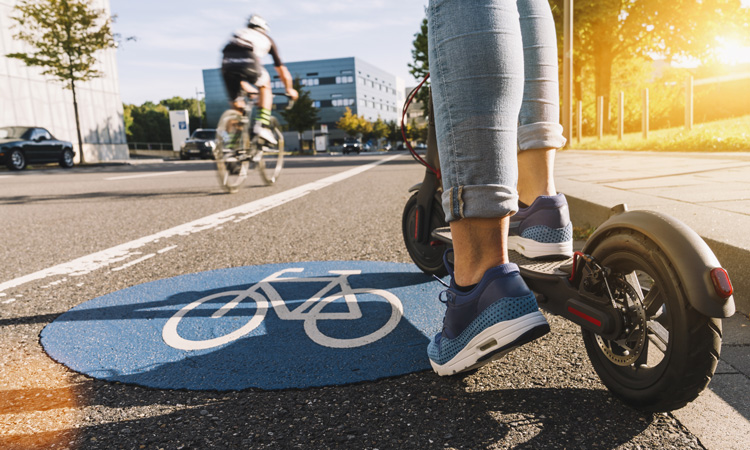ITF report outlines recommendations for safety of micromobility services
- Like
- Digg
- Del
- Tumblr
- VKontakte
- Buffer
- Love This
- Odnoklassniki
- Meneame
- Blogger
- Amazon
- Yahoo Mail
- Gmail
- AOL
- Newsvine
- HackerNews
- Evernote
- MySpace
- Mail.ru
- Viadeo
- Line
- Comments
- Yummly
- SMS
- Viber
- Telegram
- Subscribe
- Skype
- Facebook Messenger
- Kakao
- LiveJournal
- Yammer
- Edgar
- Fintel
- Mix
- Instapaper
- Copy Link
Posted: 18 February 2020 | Sam Mehmet (Intelligent Transport)
A new study by the International Transport Forum has examined safety aspects associated with e-scooters and other micro-vehicles, and has outlined 10 key safety recommendations.


As existing urban traffic patterns are being challenged by micromobility services – electric scooters, e-bikes, motorised skateboards and other light personal mobility devices – a new report published by the International Transport Forum, an intergovernmental organisation with 60 member countries, has suggested 10 recommendations for policy makers, city planners, operators and manufacturers to ensure optimised micromobility safety:
1. Allocate protected space for micromobility
Create a protected and connected network for micromobility. This can be done by calming traffic or by creating dedicated spaces. Micro-vehicles should be banned from sidewalks or subject to a low, enforced speed limit.
2. To make micromobility safe, focus on motor vehicles
The novelty of e-scooters should not distract from addressing the risk motor vehicles pose for all other road users. Where vulnerable road users share space with motor vehicles, speed limits should be 30 km/h or less.
3. Regulate low-speed micro-vehicles as bicycles
Micromobility can make urban travel more sustainable. To prevent over-regulation, low-speed micro-vehicles such as e-scooters and e-bikes should be treated as bicycles. Faster micro-vehicles should be regulated as mopeds.
4. Collect data on micro-vehicle trips and crashes
Little is known about micro-vehicles’ safety performance. Police and hospitals should collect accurate crash data. Road safety agencies should collect trip data via operators, travel surveys and on-street observation. The statistical codification of vehicle types must be updated and harmonised.
5. Proactively manage the safety performance of street networks
Many shared micro-vehicles possess motion sensors and GPS. These can yield useful data on potholes, falls and near crashes. Authorities and operators should collaborate to use them for monitoring and maintenance.
6. Include micromobility in training for road users
Training for car, bus and truck drivers to avoid crashes with micro-vehicle riders should be mandatory. Cycle training should be part of the school curriculum. Training programmes should be regularly evaluated and revised.
7. Tackle drunk driving and speeding across all vehicle types
Governments should define and enforce limits on speed, alcohol and drug use among all traffic participants. This includes motor vehicle drivers and micromobility users.
8. Eliminate incentives for micromobility riders to speed
Operators of shared micromobility fleets should ensure their pricing mechanisms do not encourage riders to take risks. By-the-minute rental can be an incentive to speed or to ignore traffic rules.
9. Improve micro-vehicle design
Manufacturers should enhance stability and road grip. Solutions could be found in pneumatic tyres, larger wheel size and frame geometry. Indicator lights could be made mandatory and brake cables better protected.
10. Reduce wider risks associated with shared micromobility operations
The use of vans for re-positioning or re-charging micro-vehicles should be minimised, as they impose additional risks on all road users. Cities should allocate parking space for micro-vehicles close to bays for support vans.
Fredrik Hjelm, co-founder and CEO of Voi, commented: “Keeping our riders and other road users safe is our number one priority and one accident is one too many. But we need to be wary of stifling transport innovation by rushing to assume that e-scooters are less safe than other modes of transport. The ITF’s report makes clear that the real danger on the roads remains motor vehicles and we believe that improving city infrastructures to better accommodate bikes, e-scooters and other light electric vehicles as well as decreasing the amount of cars in European cities will dramatically improve safety for all road users. It’s all about making the streets safe.
“Voi is working across Europe with city authorities to make sure that e-scooters are used safely and considerately, providing a fun, safe and affordable way to travel in urban environments – particularly in big cities like Berlin and Stockholm with sizeable scooter fleets in the thousands. In September 2019 we launched the world’s first online traffic school for e-scooters together with NTF (The National Society for Road Safety in Sweden). Our traffic school, RideLikeVoila, certified by VIAS (The Belgian Institute for Road Safety) and quoted in the ITF report, is a great example of things operators can do to increase the safety of scooter riders. However, policymakers, regulators and city planners are the people who can really make our cities safer – with infrastructure improvements like protected cycleways – for all users, whatever their mode of travel.”
Related topics
Fleet Management & Maintenance, Mobility Services, Passenger Accessibility, Sustainable Urban Transport, Transport Governance & Policy, Vehicle & Passenger Safety
Related modes
Bikes & Scooters
Related organisations
International Transport Forum (ITF), Voi Technology
Related people
Fredrik Hjelm








